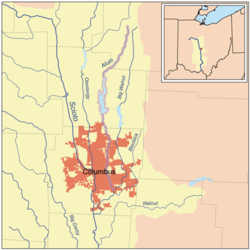Alum Creek
| Alum Creek | |
|---|---|
 The confluence of the Alum Creek and Big Walnut Creek. Alum Creek is in the center of the image and Big Walnut Creek is coming from the right. | |
| Origin | 40°32′00″N 082°49′02″W / 40.53333°N 82.81722°W[1] 1 mile (1.6 km) South-West of Mount Gilead |
| Mouth | 39°52′52″N 082°54′27″W / 39.88111°N 82.90750°WCoordinates: 39°52′52″N 082°54′27″W / 39.88111°N 82.90750°W[1] Big Walnut Creek near Obetz, Ohio |
| Basin countries | United States of America |
| Length | [2] |
| Source elevation | 1,160 feet (350 m)[3] |
| Mouth elevation | 718 feet (219 m)[1] |
| Avg. discharge | [2] |
| Basin area | 199 square miles (520 km2)[4] |

Alum Creek is 58-mile (93 km) long creek that runs north to south in central Ohio. The creek originates in Morrow County and then flows through Delaware County and finally into Franklin County, where it ends at Big Walnut Creek, which drains into the Scioto River. In 1974, the Army Corps of Engineers completed the Alum Creek Reservoir near the middle portion of the creek length. This reservoir "has a surface area of 3,387 acres of water and was created to ensure a water supply for the city of Columbus, provide flood control for the area south of the reservoir, and yield recreational opportunities."[5]
History
The Alum Creek valley was inhabited by the Adena over 2,000 years ago. This mound builder culture constructed seven mounds along Alum Creek. The Lenape (Delaware) Indian tribe later established many settlements near the creek.
One of the first European settlers was Colonel Moses Byxbe, who constructed his home on Alum Creek in 1805. Colonel Byxbe owned or co-owned 38,000 acres (150 km²) along the creek.
As a defensive measure during the War of 1812, local residents built four blockhouses in the area, including one on Alum Creek. The blockhouse, Fort Cheshire, was a 2-story log fortress, constructed so as to provide a place from which to shoot, drop boiling water, and defend against the threat of fire. The blockhouse was subsequently used as a schoolhouse and remained intact until the Civil War. The fort is commemorated by a bronze plaque where the blockhouse once stood.
Underground Railroad
The history of Alum Creek is also notable for its connection to the Underground Railroad, by which many slaves found their freedom. The Underground Railroad's Sycamore Trail ran along Alum Creek. Africa Road, near Alum Creek, is so named because of the nearby settlement of thirty freed slaves from North Carolina.[6]
Also known as
Watershed
Alum Creek Lake
Near 40°10′36″N 082°57′24″W / 40.17667°N 82.95667°W Elevation: 833 feet (254 m)[7]
Alum Creek Lake Dam
Near 40°10′36″N 082°57′24″W / 40.17667°N 82.95667°W Elevation: 833 feet (254 m)[8]
Drinking Water
Alum Creek is a source of drinking water for the city of Westerville, Ohio.[9]
Tributaries
See also
References
- ↑ 1.0 1.1 1.2 1.3 1.4 1.5 1.6 1.7 U.S. Geological Survey Geographic Names Information System: Alum Creek
- ↑ 2.0 2.1
- ↑ United States Geological Survey. Mount Gilead quadrangle, Ohio. 1:24,000. 7.5 Minute Series. Washington D.C.: United States Geological Survey, 1973.
- ↑ "Map of Ohio watersheds" (GIF). Ohio Department of Natural Resources.
- ↑ Byrom, Jack S. Assessment of the Hydrological Effects of Urbanization on the Lower Alum Creek Watershed of Central Ohio. Epistimi 2004, Vol I.
- ↑ "Alum Creek State Park".
- ↑ U.S. Geological Survey Geographic Names Information System: Alum Creek Lake
- ↑ U.S. Geological Survey Geographic Names Information System: Alum Creek Lake Dam
- ↑ "City of Westerville FAQs".
USGS Southeast Columbus, United States Geological Survey. Southeast Columbus quadrangle, Ohio. 1:24,000. 7.5 Minute Series. Washington D.C.: United States Geological Survey, 1992.